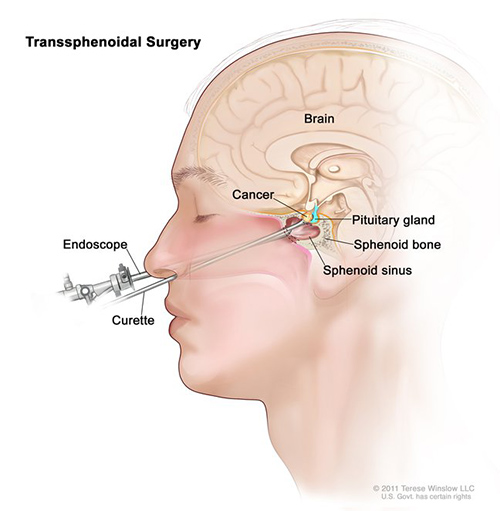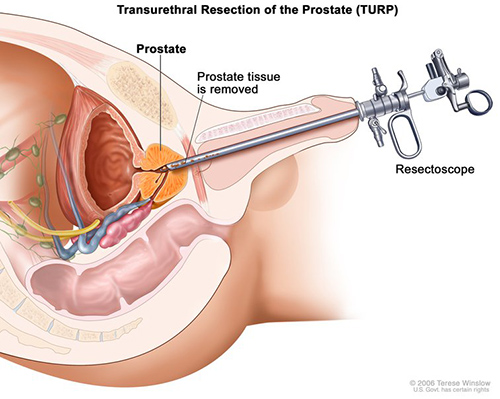Laparoscopic and Thoracoscopic Surgery
Laparoscopy is a surgical technique that involves the use of an laparoscope, a special viewing instrument that allows a surgeon to see images of the body's internal structures through very small incisions. This is considered a minimally invasive surgery.
In a typical laparoscopy or thoracoscopy procedure, only a few small incisions, each less than one inch long, are needed to insert the endoscope probe and other instruments.
It's important to understand that the laparoscope functions as a viewing device only. To perform the surgery, a separate surgical instrument--such as a scalpel, scissors, or forceps--must be inserted through a different point of entry and manipulated within the tissue. The diagrams below depict this concept. The first diagram shows a transsphenoidal surgery to remove cancer from the pituitary gland. The second diagram shows a transurethral resection of a prostate cancer using a resectoscope. The resectoscope is guided to the area of the prostate where instruments are passed though the scope to remove the cancerous area in the prostate.
Thoracoscopic Surgery - Video-assisted thoracic surgery (VATS) [1 ]
]
This surgical approach for early stage lung cancers uses a thin, rigid tube with a tiny video camera on the end that is placed through a small cut in the side of the chest to aid the surgeon in seeing inside the chest via a video monitor. One or two additional small cuts are created in the skin, and long instruments are passed through these cuts to do the same operation that would be done using an open approach (thoracotomy). If a lobectomy or pneumonectomy is performed, then one of the incisions is enlarged to allow removal of the specimen.
There are other types of scopes used for surgical procedures. As pictured below, an endoscope is used to perform transsphenoidal surgery and a resectoscope is used to perform a transurethral resection of the prostate (TURP).

Figure 1. Transsphenoidal surgery. An endoscope and a curette are inserted through the nose and sphenoid sinus to remove cancer from the pituitary gland. Source: Terese Winslow (Illustrator), National Cancer Institute.

Figure 2. Transurethral resection of the prostate (TURP). Tissue is removed from the prostate using a resectoscope (a thin, lighted tube with a cutting tool at the end) inserted through the urethra. Prostate tissue that is blocking the urethra is cut away and removed through the resectoscope.. Source: Terese Winslow (Illustrator), National Cancer Institute.
Advantages of Laparoscopic Surgery
All surgery carries risks and every incision leaves a scar. However, with laparoscopic surgery, scars are likely to be much smaller and some of the after effects of surgery may be minimized.
Back to Specialized Surgical Techniques
Updated: December 21, 2023
